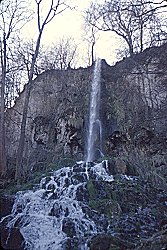Growing Rock
Growing Waterfall


A growing rock, the descriptive name actually describes exactly what happens, is one of the possible forms of a tufa deposit. The limestone is generally deposited on or in the watercourse, and can form basins, steps or gullies. Growing rock is probably the most widespread form of deposition. Here, the watercourse usually deposits lime at the edge, but it is often displaced by leaves and branches, or by gaps created by uneven growth. In this way, an entire deposit with a kind of plateau forms over time. Das Lager breitet sich fächerförmig aus und besitzt einen bogenförmigen Rand, der mit de Zeit immer höher wird.
Such calcareous tufa steps usually grow outwards more than upwards. When the stream falls over the edge, it falls down in a waterfall. This precipitates a particularly large amount of lime, and afterwards the lime content in the water is reduced to such an extent that much less lime is deposited further downstream.
The overhanging edge is quite typical, especially in the area of the waterfall an overhang forms, which every now and then breaks off and falls down due to its own weight. The result is a wall that grows upwards in front of the wall and a wall that overhangs. In this way, tuff caves form, usually in the shape of arches and at right angles to the course of the valley. Several parallel passages may also form.
The waterfalls are also very characteristic and easily recognisable as tuff falls. Firstly, there is the protruding watercourse, then quite typically there is a kind of truncated cone in the middle of the fall. And finally, the rock is porous limestone overgrown with mosses and ferns, and has small caves.
- See also
 Wasserfall Dreimühlen
Wasserfall Dreimühlen
 Index
Index Topics
Topics Hierarchical
Hierarchical Countries
Countries Maps
Maps Search
Search